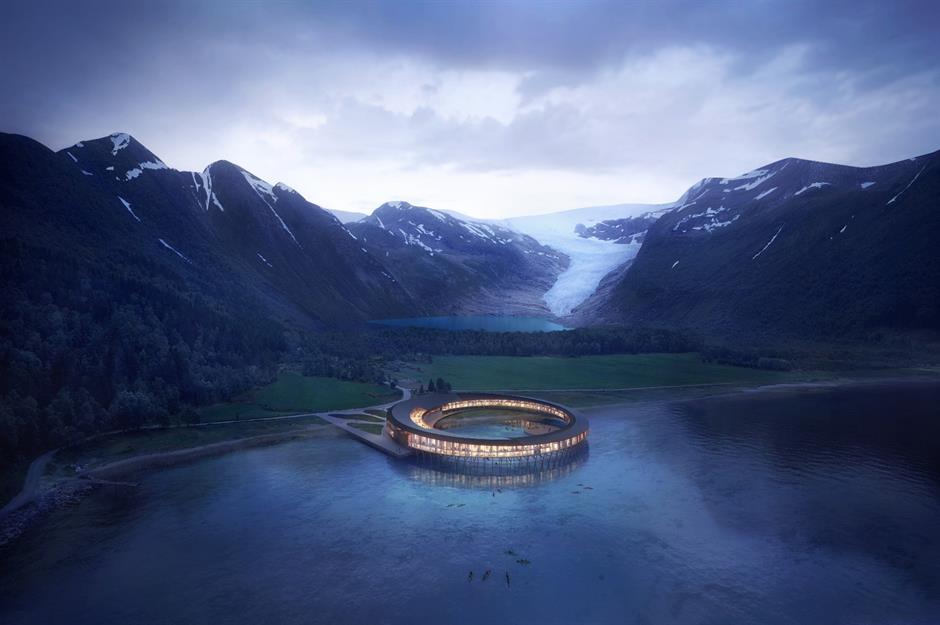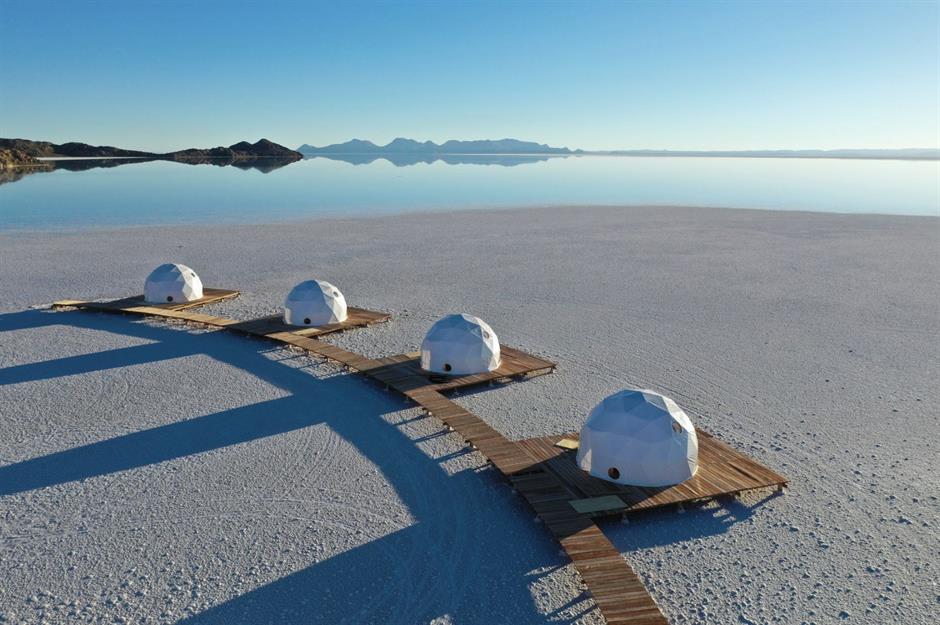The world’s best eco hotels
Climate-friendly stays
Kachi Lodge, Uyuni Salt Flats, Bolivia
The otherworldly white plains of Bolivia’s Uyuni Salt Flats provide a pretty special backdrop to this luxury eco-lodge. Situated at the base of the Tunupa volcano, at 12,000 feet (3660m) high, six white geometric domes form the hotel’s rooms. They’re linked by a wooden platform, which is secured into the salt flat (also known as salar) by wooden pillars – no drilling was done into the precious salt crust to secure the structure.
Kachi Lodge, Uyuni Salt Flats, Bolivia
Rooms are given a cosy feel with bohemian decor and paintings by Bolivian artist Gaston Ugalde. Meanwhile wood-fired stoves, which run on leftover wood pellets, keep things toasty. In the “lounge dome”, guests can enjoy a Bolivian and internationally-inspired menu made from locally sourced ingredients (cooked in the neighbouring “kitchen dome”, naturally). And thanks to the large, geometric windows, guests are never far from breathtaking views across the salar.
Kachi Lodge, Uyuni Salt Flats, Bolivia
Karijini Eco Retreat, Karijini National Park, Australia
Surrounded by endless plains, glistening pools and dramatic gorges, Karijini Eco Retreat is a great base for exploring the Western Australian outback. Better yet, it’s 100% Aboriginal-owned. Run by the Gumala Aboriginal Corporation (GAC), one of Australia’s largest Aboriginal companies, the resort helps to alleviate poverty and increase development among the Banjima, Yinhawangka and Nyiyaparli peoples.
Love this? Follow us on Facebook for more travel inspiration
Karijini Eco Retreat, Karijini National Park, Australia
Karijini Eco Retreat, Karijini National Park, Australia
A plethora of gorgeous sights are within easy reach: the atmospheric Joffre Gorge, with its steep red walls and curved waterfall; Mount Bruce, Western Australia’s second tallest mountain; the alluring Weano Gorge with its crystal clear plunge pool. The retreat holds an Advanced Ecotourism Certification from Ecotourism Australia, which recognises the country’s most innovative sustainable hotels, tour operators and attractions.
Zuri Zanzibar, Zanzibar, Tanzania
Paper-white sands, tranquil waters and swaying palms give Zanzibar all the right ingredients for paradise. And thanks to resorts like Zuri Zanzibar, visitors can tread a little lighter when they explore the Tanzanian island. Located on the postcard-perfect Kendwa Beach, this eco resort is made up of 56 beautiful villas, bungalows and suites set within a 12-acre tropical garden.
Zuri Zanzibar, Zanzibar, Tanzania
Zuri Zanzibar, Zanzibar, Tanzania
The hotel runs a waste management programme, with a focus on reducing the amount of waste that is produced, and managing it more responsibly. It has also placed waste collection points on the beach and around the local area. In 2019, Zuri Zanzibar was awarded a gold certification by sustainable tourism company Earthcheck, who said: “Sustainable design principles were integrated from the outset with the building concept respecting the original terrain configuration and utilising local materials and local architectural traditions.”
Mashpi Lodge, Mashpi, Ecuador
Northern Ecuador’s cloudforest – so-named for its high altitude, which means the trees are often hugged by low-lying clouds – is home to the beautiful Mashpi Lodge. In order to harmonise with its surroundings, the hotel was preassembled in Quito and carefully rebuilt here, to match the site’s unique topography. It was also created in a dark colour to blend in with its surroundings, using materials which counteract warming in summer and cooling in winter, and used pre-existing logging infrastructure to minimise further damage to the forest.
Mashpi Lodge, Mashpi, Ecuador
Mashpi Lodge, Mashpi, Ecuador
The hotel’s eco credentials are hard to beat. In 2001, environmentalist Roque Sevilla purchased this plot of land (which has since expanded to 2,500 hectares) with the mission of protecting it against deforestation – logging and mining companies had had their eyes on it for years. It runs mostly on hydroelectric power from Ecuador’s grid, while water supply comes from the nearby Torrenteer Waterfall. Plus, almost three-quarters of its workforce are from the local area and employees are stakeholders in the business itself.
Glenorchy Eco Retreat, Glenorchy, New Zealand
Snuggled between the Humboldt and Richardson mountain ranges of southwestern New Zealand, a 40-minute drive from Queenstown, Glenorchy Eco Retreat certainly has epic scenery galore. But that’s not all this stunning resort has going for it. The hotel, which opened in March 2018, is New Zealand’s first net-positive energy tourist destination: it generates 105% of the energy it uses in a year, using its on-site Solar Garden.
Glenorchy Eco Retreat, Glenorchy, New Zealand
Glenorchy Eco Retreat, Glenorchy, New Zealand
Bucuti & Tara Beach Resort, Aruba, Caribbean
On the little-known island of Aruba, sandwiched between swaying palms and gently-lapping azure waters, lies the first certified carbon neutral resort in North America. Bucuti & Tara Beach Resort reached the milestone in 2018 and it’s already looking to go one better, striving to become carbon negative (meaning it removes more carbon from the atmosphere than it emits). On top of all these impressive accomplishments, the adults-only resort is the height of luxury too.
Discover why these amazing beaches could disappear in our lifetimes
Bucuti & Tara Beach Resort, Aruba, Caribbean
Bucuti & Tara Beach Resort, Aruba, Caribbean
The resort has a seemingly endless list of initiatives for sustainability. It relies on local suppliers for products and services, which has helped bring down its carbon footprint; water reducers, low-flow toilets and greywater usage in the grounds have helped to minimise water waste; solar panels are used to heat water. It’s also heavily involved in the local community through programmes including beach cleans, volunteer work (more than 1,000 hours were completed in 2020), and collecting donations for a nearby orphanage.
Pikaia Lodge, Santa Cruz, Galápagos, Ecuador
The Galápagos islands are renowned for their incredible biodiversity and Pikaia Lodge aims to showcase and protect it. Enjoying a prime location on Santa Cruz island at the heart of the archipelago, the lodge sits on the precipice of a volcanic crater, straddling higher-elevation tropical forests and lower-elevation arid savannah. Since its inception in 2006, it has sought to reforest land which was razed by cattle ranching, and numbers of native tortoise and bird species in the area are already bouncing back.
Pikaia Lodge, Santa Cruz, Galápagos, Ecuador
Pikaia Lodge, Santa Cruz, Galápagos, Ecuador
Soneva Kiri, Koh Kood, Thailand
Tucked away on the lesser-visited Thai island of Koh Kood, Soneva Kiri is surrounded by tropical rainforest and practically empty beaches. The resort is part of the Soneva hotel group, which has been 100% carbon neutral since 2012 – impressively, that figure even includes offsetting the carbon of guests’ flights. This is achieved through a 2% levy on all stays which is used for carbon-reducing projects, including installing a 1.5-megawatt windmill in India, planting 500,000 trees in northern Thailand and installing smoke-reducing cook stoves in Darfur and Myanmar.
Soneva Kiri, Koh Kood, Thailand
The resort is the epitome of laid-back luxury. Made up of 34 decadent villas, which range in size from one to six bedrooms, each is decorated in a minimalistic way, with wooden interiors, sumptuous white bedding and earth-toned soft furnishings. Outside, private pools lined with plush daybeds make it even easier to kick back and relax. There are plenty of tantalising dining options too, from traditional Thai fare at Kruua Mae Tuk, to Japanese and Persian fusion food at The View (which, as you’d expect, looks out onto a stunning view across the Gulf of Thailand).
Soneva Kiri, Koh Kood, Thailand
In 2008, the hotel group stopped providing branded plastic water bottles at its resorts and started producing its own drinking water. This has helped fund more than 500 projects improving drinking water supply and sanitation in more than 50 countries, which are run through the Soneva Foundation. The group also recycles 90% of all its solid waste, some of which is used for innovative projects. For example the Soneva Glass Studio invites esteemed artists to create unique and beautiful glassware for resorts from waste glass.
Now for Tomorrow initiative, Mauritius
The balmy island of Mauritius, located in the heart of the Indian Ocean around 500 miles (800km) east of Madagascar, is a dream holiday destination for many. And initiatives like Now for Tomorrow are helping protect this gorgeous island for future generations. The eco-friendly initiative is being run by Heritage Resorts, with two hotels on the island; and Veranda Resorts, with five hotels on the island.
Now for Tomorrow initiative, Mauritius
Now for Tomorrow initiative, Mauritius
Svart, Svartisen, Norway
Every aspect of Svart, located in Svartisen in Norway’s Arctic Circle, is being designed with energy efficiency and carbon reduction in mind. The hotly anticipated resort, which is set for completion in 2022, will be energy-positive – meaning it’ll produce more energy than it uses. This will be achieved through inbuilt solar panels, which will absorb sunlight reflected off the nearby Svartisen glacier.
Svart, Svartisen, Norway
Svart, Svartisen, Norway
Those who visit will be rewarded with breathtaking views, and equally breathtaking temperatures, which average around 9°C to 12°C (48-54°F) in the summer and hover between -4°C to -7°C (25-19°F) in the winter. There are plenty of gorgeous sights to take the edge off the chill, though, including gazing at the Svartisen glacier, exploring the crystal-clear Holandsfjorden fjord and even possibly catching the Northern Lights.
Now check out these incredible images which show the true impact of climate change

